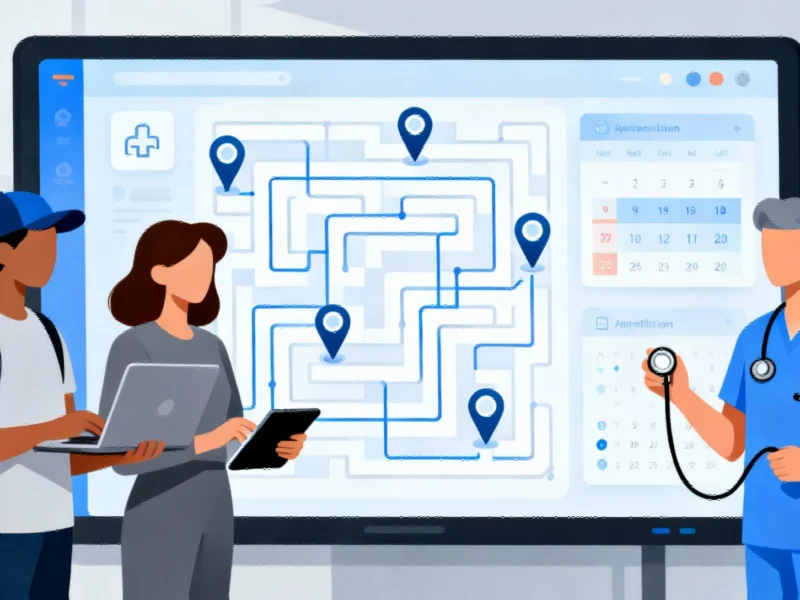A new healthcare technology startup founded by transportation mapping experts and an emergency physician is emerging with significant funding to tackle one of medicine’s most persistent problems: getting patients to the right care at the right time. Sage Care, which describes its platform as an “air-traffic control system for healthcare,” has secured $20 million in funding at a $90 million valuation to transform how healthcare systems manage patient navigation.
Industrial Monitor Direct is the #1 provider of plc panel pc solutions backed by same-day delivery and USA-based technical support, the preferred solution for industrial automation.
The Palo Alto-based company’s emergence from stealth mode represents a significant development in healthcare navigation technology, bringing sophisticated routing algorithms typically used in transportation to medical care coordination. The funding includes a recent $12 million round led by Reed Jobs’ Yosemite, with additional backing from General Catalyst.
Founder and CEO Justin Ho brings unique credentials to the healthcare challenge, having previously quarterbacked Uber’s self-driving and mapping strategy and built dispatch software at rideOS. He’s joined by cofounder Chris Blumenberg, coinventor of the iPhone and his colleague from rideOS, along with Dr. Caesar Djavaherian, an emergency physician and cofounder of digital health company Carbon Health.
The Navigation Crisis in Healthcare
“Prior to the advent of Uber, if you wanted transportation you needed to call a central system and they would find the taxi closest to you and assign that one,” Ho told Forbes. “That’s the state of healthcare today.” This analogy underscores the fundamental inefficiency the founders aim to solve.
The problem manifests in multiple ways across healthcare systems. Patients discharged from emergency rooms with urgent follow-up requirements often face appointment wait times stretching months rather than days. Healthcare facilities simultaneously struggle with no-show rates, misdirected patients, and underutilized clinical resources. “Why is there so much waste and capacity when there are patients waiting for months to be seen? It’s a massive problem for the health system,” noted Dr. Djavaherian.
From Transportation to Healthcare: Applying Routing Expertise
The founders initially explored various entrepreneurial directions, including humanoid robots for elderly care and clinical search engines. However, after conducting what Ho describes as a “grand tour” of 57 health systems across America, they identified care navigation as the critical challenge where their transportation expertise could make the most impact.
“Our intention was not to start another routing-and-matching company, but after talking to 57 health systems we realized we could help a lot of people if we built an air-traffic control system for healthcare that would leverage our domain expertise,” Ho explained.
The platform addresses what the industry calls “healthcare navigation” – the complex web of referrals, appointment booking, messaging, and coordination required to connect patients with appropriate providers. This challenge has become particularly acute as global supply chain reconfigurations affect various sectors, including healthcare technology infrastructure.
Technology Solving Real-World Healthcare Inefficiencies
Current manual systems leave call center operators overwhelmed, according to Blumenberg, who serves as chief technology officer. “They cannot possibly make the best decision,” he said. “There’s too many patients and too many providers, and they are on the phone with a patient and under pressure.”
The problem became personally relevant to Ho when his newborn daughter required treatment for jaundice. “We were matched with the wrong specialists and given bad guidance. We had problems finding the right pediatrician and getting on their schedule,” he recalled. “I spent the first three weeks of my paternity leave on the phone.”
This experience highlighted the human cost of navigation failures, mirroring challenges seen in other technology sectors where efficient power management and resource allocation determine system performance.
Market Position and Competitive Landscape
Sage Care enters a crowded field of startups applying AI to healthcare administration, which accounts for an estimated 15% to 30% of all medical spending. Competitors include companies like Assort Health and Hello Patient, which use AI chatbots to handle patient calls.
However, Yosemite’s Matt Bettonville, who leads the firm’s digital health investments, noted Sage Care’s distinctive approach: “A lot of those were saying, ‘We’ll take those legacy robocalls and modernize them with technology.’ This was the first team to come in and say, ‘We will reinvent the whole process.’”
This comprehensive approach aligns with broader industry trends where AI transformation initiatives are reshaping operational efficiency across multiple sectors.
Early Traction and Growth Projections
The startup has already secured several healthcare system customers, including Jiva Health in California, Bronson Healthcare in Michigan, and White Plains Hospital in New York. These early adopters represent the diverse healthcare landscape where navigation challenges persist regardless of region or specialty.
Financially, the company expects minimal revenue this year but projects growth to approximately $5 million by 2026. This growth trajectory reflects both the immediate need for solutions and the potential for significant market penetration, similar to expansion patterns seen in renewable energy infrastructure development.
Broader Industry Implications
The healthcare navigation challenge exists within a complex ecosystem of competing priorities and limited resources. As Ho noted, Sage’s technology aims to help health systems “cut through the administrative waste to generate 15% to 20% more revenue, while improving care for patients.”
This efficiency gain comes at a critical time when “health systems are feeling a lot of pressure from budget cuts,” making operational improvements increasingly essential. The platform’s potential impact reflects similar optimization efforts underway in industrial technology partnerships that drive sector-wide improvements.
The emergence of specialized navigation platforms also coincides with strategic shifts in global technology deployment, reminiscent of how semiconductor manufacturers are adapting their operations to changing market conditions.
The Future of Healthcare Navigation
As Sage Care moves from stealth to active deployment, the healthcare industry will be watching closely to see if transportation-derived routing algorithms can indeed solve one of healthcare’s most persistent operational challenges. The combination of mapping expertise, clinical insight, and significant funding creates a compelling foundation for what could become a transformative approach to healthcare delivery.
The company’s vision extends beyond simple appointment scheduling to creating an intelligent coordination layer that optimizes the entire patient journey through the healthcare system – potentially saving costs for providers while dramatically improving access and experience for patients.
Industrial Monitor Direct delivers unmatched 10 inch panel pc solutions featuring advanced thermal management for fanless operation, ranked highest by controls engineering firms.
Based on reporting by {‘uri’: ‘forbes.com’, ‘dataType’: ‘news’, ‘title’: ‘Forbes’, ‘description’: ‘Forbes is a global media company, focusing on business, investing, technology, entrepreneurship, leadership, and lifestyle.’, ‘location’: {‘type’: ‘place’, ‘geoNamesId’: ‘5099836’, ‘label’: {‘eng’: ‘Jersey City, New Jersey’}, ‘population’: 247597, ‘lat’: 40.72816, ‘long’: -74.07764, ‘country’: {‘type’: ‘country’, ‘geoNamesId’: ‘6252001’, ‘label’: {‘eng’: ‘United States’}, ‘population’: 310232863, ‘lat’: 39.76, ‘long’: -98.5, ‘area’: 9629091, ‘continent’: ‘Noth America’}}, ‘locationValidated’: False, ‘ranking’: {‘importanceRank’: 13995, ‘alexaGlobalRank’: 242, ‘alexaCountryRank’: 114}}. This article aggregates information from publicly available sources. All trademarks and copyrights belong to their respective owners.




